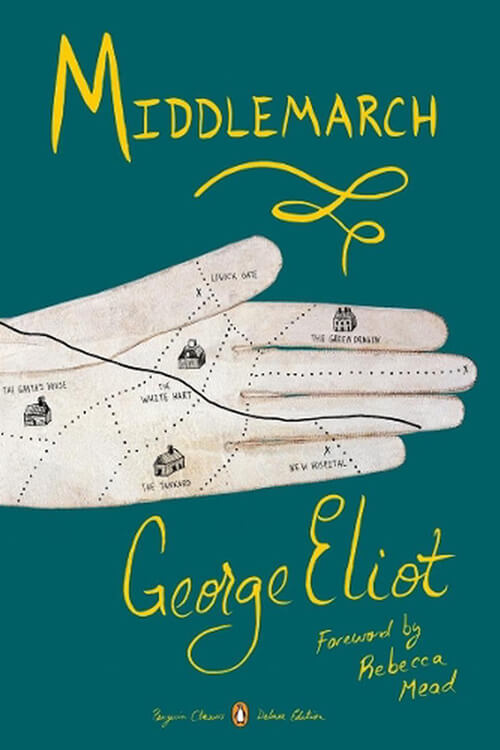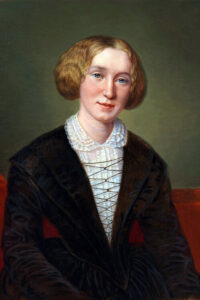
Middlemarch, A Study of Provincial Life
Who that cares much to know the history of man, and how the mysterious mixture behaves under the varying experiments of Time, has not dwelt, at least briefly, on the life of Saint Theresa, has not smiled with some gentleness at the thought of the little girl walking forth one morning hand-in-hand with her still smaller brother, to go and seek martyrdom in the country of the Moors? Out they toddled from rugged Avila, wide-eyed and helpless-looking as two fawns, but with human hearts, already beating to a national idea; until domestic reality met them in the shape of uncles, and turned them back from their great resolve. That child pilgrimage was a fit beginning. Theresa’s passionate, ideal nature demanded an epic life: what were many-volumed romances of chivalry and the social conquests of a brilliant girl to her? Her flame quickly burned up that light fuel; and, fed from within, soared after some illimitable satisfaction, some object which would never justify weariness, which would reconcile self-despair with the rapturous consciousness of life beyond self. She found her epos in the reform of a religious order.
That Spanish woman who lived three hundred years ago was certainly not the last of her kind. Many Theresas have been born who found for themselves no epic life wherein there was a constant unfolding of far-resonant action; perhaps only a life of mistakes, the offspring of a certain spiritual grandeur ill-matched with the meanness of opportunity; perhaps a tragic failure which found no sacred poet and sank unwept into oblivion. With dim lights and tangled circumstances, they tried to shape their thought and deed in noble agreement; but after all, to common eyes, their struggles seemed mere inconsistency and formlessness; for these later-born Theresas were helped by no coherent social faith and order which could perform the function of knowledge for the ardently willing soul. Their ardor alternated between a vague ideal and the common yearning of womanhood; so that the one was disapproved as extravagance, and the other condemned as a lapse.
Read or download Book
George Eliot
Mary Ann Evans (22 November 1819 – 22 December 1880), known by her pen name George Eliot, was an English novelist, poet, journalist, translator, and one of the leading writers of the Victorian era. She wrote seven novels: Adam Bede (1859), The Mill on the Floss (1860), Silas Marner (1861), Romola (1862–1863), Felix Holt, the Radical (1866), Middlemarch (1871–1872) and Daniel Deronda (1876). Like Charles Dickens and Thomas Hardy, she emerged from provincial England; most of her works are set there. Her works are known for their realism, psychological insight, sense of place, and detailed depiction of the countryside.
Middlemarch was described by the novelist Virginia Woolf as “one of the few English novels written for grown-up people” and by Martin Amis and Julian Barnes as the greatest novel in the English language.
Life
Mary Ann Evans was born in Nuneaton, Warwickshire, England, at South Farm on the Arbury Hall estate. She was the third child of Welshman Robert Evans (1773–1849), manager of the Arbury Hall estate, and Christiana Evans (née Pearson, 1788–1836), daughter of a local mill owner. Her full siblings were: Christiana, known as Chrissey (1814–59), Isaac (1816–1890), and twin brothers who died a few days after birth in March 1821. She also had a half-brother, Robert Evans (1802–64), and half-sister, Frances “Fanny” Evans Houghton (1805–82), from her father’s previous marriage to Harriet Poynton (1780–1809). In early 1820, the family moved to a house named Griff House, between Nuneaton and Bedworth.
The young Evans was a voracious reader and intelligent. Because she was not considered physically beautiful, Evans was not thought to have much chance of marriage, and this, coupled with her intelligence, led her father to invest in an education not often afforded to women. From ages five to nine, she boarded with her sister Chrissey at Miss Latham’s school in Attleborough, from ages nine to thirteen at Mrs. Wallington’s school in Nuneaton, and from ages thirteen to sixteen at Miss Franklin’s school in Coventry. At Mrs. Wallington’s school, she was taught by the evangelical Maria Lewis—to whom her earliest surviving letters are addressed. In the religious atmosphere of Misse Franklin’s school, Evans was exposed to a quiet, disciplined belief opposed to evangelicalism.
After age sixteen, Evans had little formal education. Thanks to her father’s important role on the estate, she was allowed access to the library of Arbury Hall, which greatly aided her self-education and breadth of learning. Her classical education left its mark; Christopher Stray has observed that “George Eliot’s novels draw heavily on Greek literature (only one of her books can be printed correctly without the use of a Greek typeface), and her themes are often influenced by Greek tragedy”. Her frequent visits to the estate also allowed her to contrast the wealth in which the local landowner lived with the lives of the often much poorer people on the estate, and different lives lived in parallel would reappear in many of her works. The other important early influence in her life was religion. She was brought up within a low-church Anglican family, but at that time the Midlands was an area with a growing number of religious dissenters.






